Madrid, Spain’s vibrant capital, isn’t just a hub for art, cuisine, and lively nightlife; it’s also the perfect starting point for adventurers exploring the country’s diverse offerings. From the historic walls of Toledo or Segovia Aqueduct to the royal palaces of Aranjuez and El Escorial, beyond Madrid’s bustling Gran Vía, a world of historic towns, lush vineyards, and breathtaking landscapes awaits.
As a Madrid resident myself, I have spent a lot of time exploring the fringes of the city and the nearby neighbours, and as much as I love the city, there are so many things to do outside Madrid; it is fun to explore. So I thought I would share my insights and put together some of my top recommendations for the best day trips from Madrid.
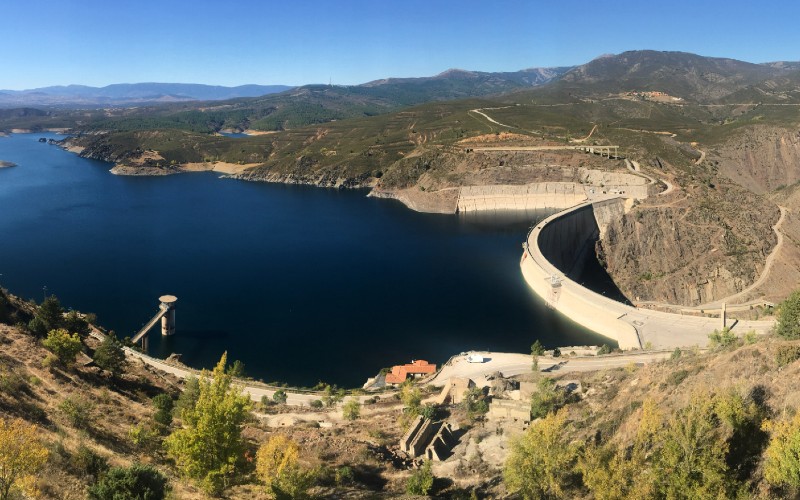
The Sierra de Guadarrama (Madrid Mountains) hide traditional villages and beautiful hiking routes, wine tasting can be enjoyed surprisingly close or just a couple of hours away you’ll find the locals favourite Ribera del Duero region wine region. With easy access to the Renfe AVE (high-speed train), local buses, or guided tour services, it may surprise you what you can fit into a day trip.
This list is a mixture of cities near Madrid that you can easily reach by public transport as well as things to do in surrounding towns and villages that you may need to hire a car for. For each recommendation, I have also included information about how to get there.
Finally, Spain loves food and everywhere you go is fiercely proud of their local fare, so you can rest assured I have included mentions of local cuisine or specific dishes that you should explore on your day trips. So, now I have whetted your appetite, let’s get going.
1. Segovia
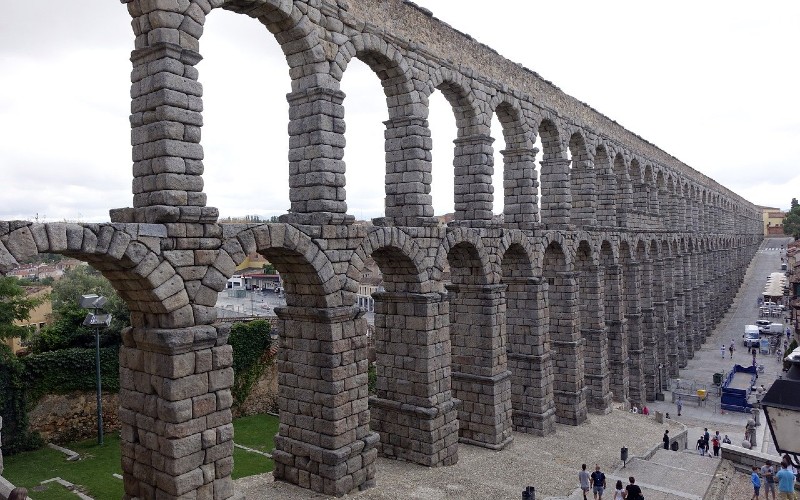
This is one of the most popular cities close to Madrid and definitely one of my favourite Madrid day trips. It is the one I recommend all of my friends take when they visit me, so I’ve become a pretty good tour guide for the city after my multiple visits to Segovia.
The city is home to one of the finest surviving Roman Aqueducts in the world (allegedly built by the Devil!), as well as an impenetrable castle that may have inspired Disney and a stunning cathedral.
What I love about the city is it is super easy to get to by train and just the perfect size for a day trip. You can easily explore the key sites and return to Madrid for dinner.
I highly recommend checking out my post specifically about a day trip to Segovia from Madrid. In it, I spill all the details about how to get there, my recommended itinerary, and more about what you can expect to see. Hopefully, you’ll understand why I always recommend it as my best day trip from Madrid.
Top things to see in Segovia
- The Segovia Aqueduct – dates back to 50AD and is rumoured to have been built by the Devil after a local youngling tricked him.
- Alcázar of Segovia – one of the few castles in Spain that has never been taken by force. Also allegedly one of the major inspirations for Walt Disney’s castle.
- Segovia Cathedral – a gigantic Gothic-style masterpiece known as the “Lady of Cathedrals” for its architectural beauty and significance in the region’s religious history. Don’t miss the wonderful views from the bell tower.
- Jewish Quarter – discover the city’s multicultural past and its significance to the cultural fabric.
What to eat
- Cochinillo Asado – a local traditional roasted pig fed on a special diet and cooked in a special oven.
How to get to Segovia from Madrid
The easiest way is by high-speed train from Madrid Chamartin station. The Segovia train station is a bit outside of the city itself, so when you arrive you will require a quick bus or taxi ride to get into the centre. The train takes around 30 mins from Madrid to Segovia.
There is a bus option, but it takes a bit longer, or you can hire a car and drive yourself which will take around an hour and a half. You can read more advice about getting to Segovia from Madrid here.
2. Toledo
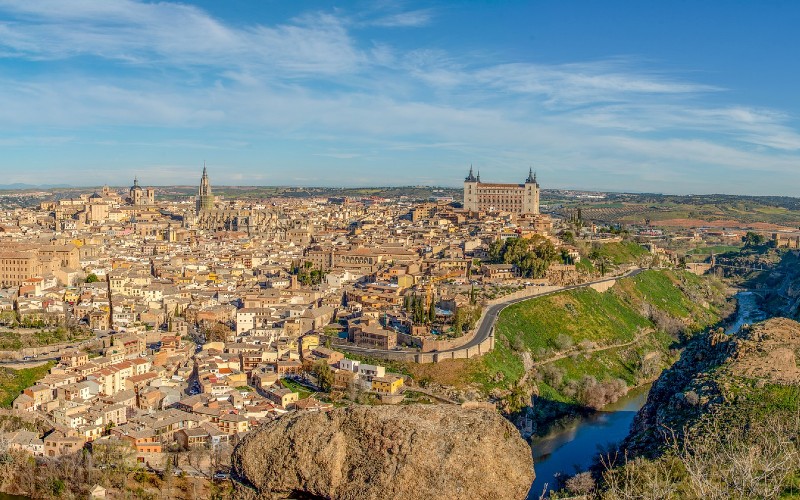
Another really popular day trip from Madrid is to Toledo, the old capital of Spain and a Toledo’s Historic City Centre is recognised as a UNESCO World Heritage Site since 1986. It is around one hour by car from Madrid or just 30 minutes by Renfe AVE high-speed train from Madrid’s Atocha station.
Just bear in mind, if you are taking the train, Toledo Railway station is at the bottom of a hill and the city at the top. There are buses or you can take a taxi to the top and still back. The taxi costs around 6 euros.
The city was once the capital of Spain and is also known as “The City of Three Cultures”, a nod to being one of the few places that the Jewish, Muslim and Christian cultures co-existed in relative peace.
One thing that you will certainly notice on a Toledo day trip are the many shops that sell awesome swords. This is due to the city’s historical metalworking industry. The manufacture of swords in the city goes back to Roman times, but it was under Moorish rule and the reconquest years, 15th to 17th centuries, that the city’s sword-makers were widely recognised as the most talented around and Toledo swords came to be regarded as the best in Europe.
If you are looking for the perfect Toledo souvenirs then a sword would be the right choice. Of course, you may want to check your airline baggage rules before buying that 15th-century replica broadsword that would have had William Wallace running in fear!
Top things to see and do in Toledo
- Toledo Cathedral (Primate Cathedral of Saint Mary of Toledo) – A gothic masterpiece dating to the 13th century.
- El Greco Museum – one of Spain’s most iconic artists. The museum is a recreation of the artists home.
- The Alcázar of Toledo – An imposing castle and key historical fortress on the cities highest point. Visit for panoramic views and home to an military Museum.
- Puente de San Martin – a picturesque medieval bridge across the River Tagus.
- Synagogue of Santa María la Blanca: Emblematic of Toledo’s rich religious history, showcasing the coexistence of Christian, Muslim, and Jewish cultures.
What to eat
- Marzipan – A local speciality. The Toledano are experts at crafting swords and stunning marzipan desserts. You’ll find it in bakeries throughout the city.
- Carcamusas: A traditional Toledo dish made with pork, peas, and tomato sauce, offering a taste of local cuisine.
How to get to Toledo from Madrid
You can drive south from Madrid for about an hour and you’ll get straight there. It’s a simple motorway so little chance of getting lost, although the road does get pretty busy at rush hour. The Madrid to Toledo train runs on average 8 times a day, leaving approximately every two and a half hours, between 6:50 am and 9:50 pm from Madrid’s Atocha station. Depending on which train you take, the travel time is between 33 – 60 minutes.
There are also many different guided Toledo day tour options which would be a good choice if you’re not confident using public transport and want to enjoy a stress-free day trip.
3. Cuenca
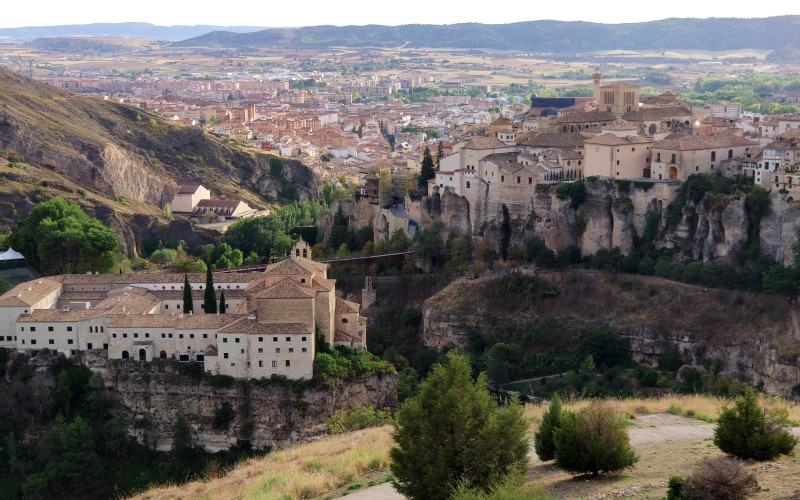
Sat high atop a spur between the Júcar and Huécar rivers, another one of my favourite Madrid side trips is a day in Cuenca, Castilla La Mancha.
The most famous site in Cuenca is the Casas Colgadas – the Hanging Houses. Dating back to the 15th Century, the houses were built into the cliff overlooking the steep ravine. The wooden balconies are synonymous with the city and certainly not a place for anyone with a fear of heights.
If you visit Cuenca, I would recommend starting in the castle area and working your way through the steep cobbled streets down into the main town. From here you can head to the hanging houses, cross the river over the spine chilling St Paul Bridge and work your way down to the lower part of the city.
If you are visiting with kids, I would certainly recommend allowing some time to visit the Paleontological Museum of Cuenca. It’s about a 20-minute walk from the centre or a quick taxi ride, but you’ll find a nice museum with many dinosaurs to entertain the little ones. My kids loved it up until the point they got pounced on by a man in an animatronic raptor suit; suddenly, they weren’t so brave!
The views back to the city are also pretty spectacular.
Top things to see in Cuenca
- Hanging Houses of Cuenca (Casas Colgadas) – the most iconic sight in Cuenca, these houses appear to cling perilously to the cliff edges. They are a must-see and highly photogenic.
- Cuenca Cathedral (Catedral de Santa María y San Julián) – Located in the main square surrounded by colourful houses. One of the oldest examples of Gothic architecture in Spain, offering visitors a chance to explore its rich history and impressive art collection.
- Saint Paul Bridge (Puente de San Pablo) – A stunning walking bridge offering the best views of the Hanging Houses and the Huécar gorge. It’s a favourite spot for photographers, and sightseers. You may be OK, but the gaps in the floor, the slight swinging and the height certainly made me feel very uneasy!
- The Castle – not much of a castle left, but wonderful views and lots of restaurants.
- Paleontological Museum of Cuenca – Great for kids and wonderful views back to Cuenca
If you can stay for longer, you may also enjoy the stunning Serrania de Cuenca National Park
What to eat
- Pisto Manchego – a delicious local dish made from vegetables (similar to ratatouille) served with a fried egg on top. I’m sorry to say though, wherever you eat it, it won’t be as good as my mother-in-law’s.
- Alajú – A traditional sweet from Cuenca made with almonds, honey, breadcrumbs, and various spices, wrapped in a thin wafer.
How to get to Cuenca from Madrid
As with most of these day trips from Madrid, the most sensible option would be the Renfe AVE train from Madrid-Atocha Train Station. It takes just an hour (give or take a few minutes depending on the train you choose) for the high-speed train from Madrid to Cuenca to complete the journey.
Compare that to the standard train, which takes about 3 and a half hours, or driving, which is about 2 and a half hours. The fast train is by far the best option for a day trip to Cuenca.
Just bear in mind, as with most of the high-speed train stations, Cuenca Fernando Zóbel Train Station is located a fair way outside the city and will require a taxi ride that takes around 10 – 15 mins and costs in the region of €12.
4. Madrid Wine Tour

While regions such as Rioja and Ribera Del Duero dominate Spanish wine fame, Madrid actually has its very own Denominación de Origen—Vinos De Madrid DO. This official designation covers several wine-producing zones in the Madrid region: San Martin and Navalcarnero to the Southeast and Arganda, the largest, to the southwest. The great thing is that all of them are accessible via public transport.
Yes, you read that right, no need to drive so you can sample as much as you’d like (although driving is a bit easier)
However, my best recommendation when visiting vineyards while tight on time is enjoying one of the day tours from Madrid and let someone else do the thinking.
If you did want to plan your own itinerary, I’d recommend reading this post that I have written for the Winerist website . It has all the details you need to know about reaching Madrid’s vineyards via public transport.
A few vineyards to look out for include Bodega del Real Cortijo in Aranjuez, Bodega Del Nero in Chinchon and Bodega Licina Wines in Morata de Tajuña.
The wine varieties of Garnacha, Tempranillo, and Albillo, are prominent in the region.
Also, be sure to check out my tips on flying with wine, as you’ll be wanting to take some back home with you!
Top things to see in the Madrid vineyards
- Vines
- Grapes
- Glasses
- Wine
What to eat
Don’t . . . drink the wine
How to get to the Madrid vineyards
In the post linked above, you can see the public transport links to reach the vineyards, they involve either a train or the bus. However, a tour would be my recommended option, or if you have a partner who is willing to drive, this is by far the easiest way. I would recommend Arganda as the place to plan most of your visits, however, San Martin does have a lovely reservoir and “beach” you can visit as part of the day trip.
5. The Madrid Mountains
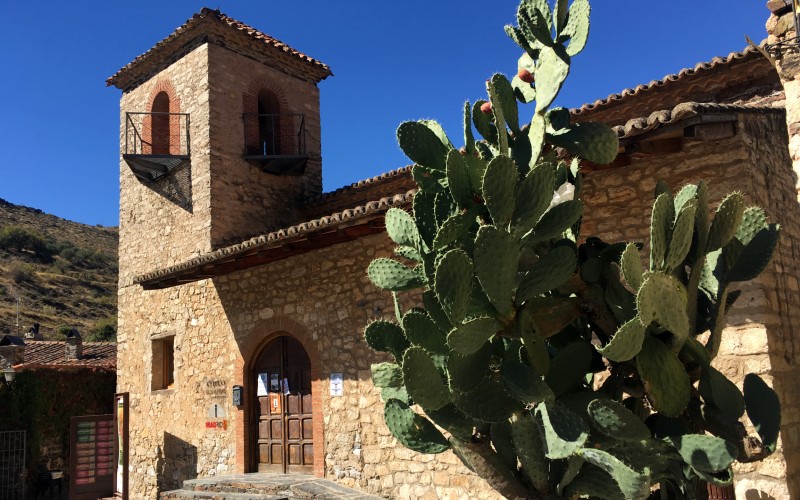
Just about an hour out of Madrid, you will find the Sierra de Guadarrama, Sierra del Norte and the Sierra de Gredos mountain ranges. I’ll be honest, they are no Alps, but they do offer a wonderful respite from the hectic pace of city life and in fact, many Madrileños own second homes in the area.
During the summer, the Madrid Mountains offer some excellent hiking, cycling and bird watching opportunities and in a good Winter, there are even some pretty decent ski ports for a few winter sports. It is possible to reach some of the areas by train, but if you really want to see the best spots, you either have to do it by car and drive yourself or take a tour.
Aside from hiking, there are some fantastic little villages to be explored. Puebla de la Sierra is a nice little village with a very good restaurant and easy hiking routes. But my favourite I have discovered (so far) is Patones de Arriba.
I have been there a few times now and it is such a picturesque little village. Sitting high up in the mountains, you are not allowed to drive into it, so you have to park your car and walk. It is possible to drive close, but most people leave their car at the bottom in the more modern village of Patones and hike up.
If you do drive to Patones de Arriba, be sure to leave time to go a little further up the road and check out El Atazar so you get some awesome views over the Atazar Reservoir (Madrid’s largest reservoir) and drive across the dam.
Top places to see in the Madrid Mountains
- Parador de Gredos – Historic hotel from where numerous hiking trails start.
- Buitrago del Lozoya – Notable for its well-preserved medieval walls and Mudejar-style castle.
- Patones de Arriba – my favourite village I have found so far. It takes a bit of effort to get there, but well worth it.
- Puebla de la Sierra – Another cute little village with a great restaurant in the main square
- Rascafria – Close to a reservoir, Rascafria is a great spot for hikes and natural swimming pools.
What to eat
Anything in Rey de Patones – an amazing restaurant, but be sure to check your bank balance first!
How to get to there
Hiring a car is really the best option for this day trip.
6. Salamanca
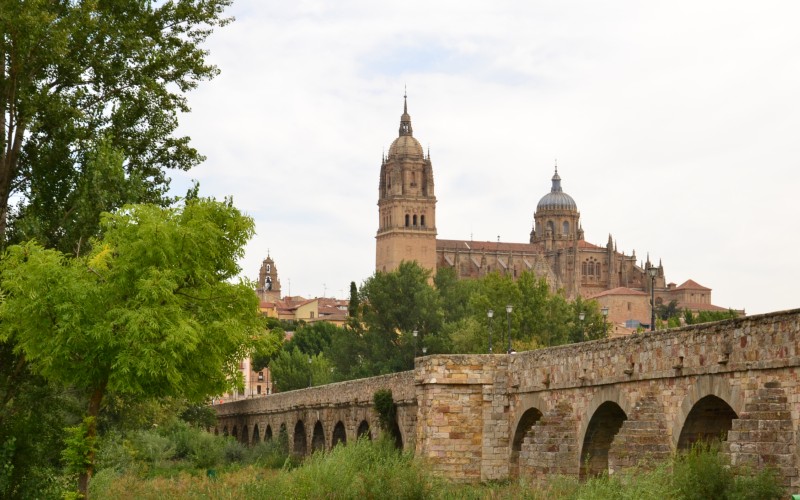
Believe it or not, the famous university city of Salamanca is just a little over two hours away and is certainly possible to visit on a one-day trip from Madrid.
I’m lucky to have visited the city numerous times as my wife’s family have a place in the Sierra de Francia mountains, one of my favourite places in Spain. But this is not about that; this is about Salamanca.
The biggest thing in the city is the university, it was the first one in Spain and is widely recognised as one of the best in the world with students from around the globe. As you would expect, this gives the city a rather sophisticated feel of one steeped in academic history.
Two places in Salamanca stand out to me. First, the Plaza Mayor. Alongside Madrid, it is one of my favourite plaza mayors in Spain. Decadent facades are on all four sides, and there is a great little microbrewery to grab a drink, sit, and enjoy some people-watching. You’ll also find the Visitor Information Centre here.
My other highlight is crossing the pedestrianised Roman Bridge. When you reach the far side there are wonderful views back to the city and you can even find a little stony beach on the shore of the river to relax by.
Top things to do in Salamanca
- University of Salamanca – One of the oldest universities in the world, offering rich architectural and academic heritage.
- Plaza Mayor – Salamanca’s main square and a fine example of Baroque architecture, often bustling with cafes and tourist activities.
- Casa de las Conchas – A historical building known for its shell-covered façade and its mix of Gothic and Renaissance elements.
- Cathedral of Salamanca – Include both the Old and New Cathedrals, notable for their distinct architectural styles and historical importance. Make sure you hunt for the spaceman on the Cathedral door! Really!
- Convento de San Esteban – A stunning convent known for its ornate plateresque facade and its historical significance in the religious and political history of Spain.
- The Roman bridge – Cross the River Tormes for lovely views of the city.
What to eat
- Hornazo – A local speciality which is an oven-baked meat pie, but a bit more like bread than pastry, usually stuffed with pork loin, spicy chorizo, and hard-boiled eggs.
How to get to Salamanca from Madrid
The only real way to enjoy a day trip from Madrid to Salamanca is by driving yourself, it takes about two hours to drive to the city. It is possible to get the train, however, the first high speed departure from Madrid leaves just after 10 am and you don’t arrive in Salamanca until nearly 12 pm. You have to get the train back around 6pm so that only leaves you 6 hours to enjoy the city, which is enough if you are ninja fast, but not to see it all.
It would be a good option if you want an overnight visit. There are regular buses from Madrid to Salamanca, operated by Avanzabus. They leave from the Madrid Sur bus station but take a little over 3 hours to arrive in Salamanca.
7. Seville
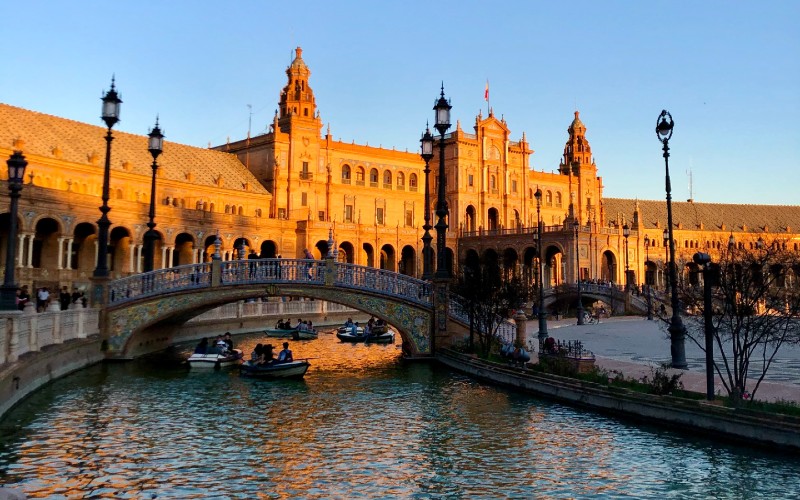
I know what you’re thinking, Seville? Really? A day trip? Well, stick with me here as with the AVE High-Speed Train, it is totally possible to take day trips from Madrid to Seville, in fact, I have a whole post about it complete with a Seville in a day itinerary. But is it worth it? Of course. I fell in love with the city on my visit.
Seville is the capital of the Andalusia region of Spain. Famous for Flamenco and the traditional Spanish pastime of bullfighting. Now, personally, I hate the “sport” of killing a bull and I don’t feel it has a place in the modern world, but there is quite a history and prestige to it and, it is said that as a Matador if you can make it there, you can make it anywhere.
Further back there is a massive Moorish influence on the city, which most represented the Alcazar of Seville, an amazing palace to visit and even a filming site for the Game of Thrones.
Seville is also home to the world’s largest cathedral the the tomb of Christopher Columbus, a tower of gold, delicious tapas and weird architecture in the shape of mushrooms.
However, as amazing as it is, a day trip to Seville from Madrid is not cheap, but it is definitely worth it.
Top things to see in Seville
- A flamenco show in Triana- after all, this district in Seville is the birthplace of this emotional dance.
- The Alcázar of Seville – A must-see UNESCO World Heritage site. Just dripping in decadence and you’ll never want to leave the garden.
- The Cathedral and Bell Tower – the largest cathedral in the world and a bell tower you can climb, what’s not to love?
- The streets of the old Jewish Quarter – Great food & great stories, you can really get into the history of Seville in this area.
- Plaza de España – It’s famous for its semi-circular brick building, ornamental bridges, and beautiful ceramic tiles located in María Luisa Park. Also, a filming spot for the Star Wars prequel trilogy.
- Metropol Parasol – Known locally as Las Setas, this is a modern architectural wonder. The large wooden structure fills a plaza and you can get on top of it for some fantastic views.
What to eat
- Secreto Iberico – a cut of pork that just melts in your mouth
- Gazpacho or Salmorejo – tomato-based Andalusian soups served chilled
How to get to Seville from Madrid
If you want to take a day trip to Seville, the high-speed train is your only real option as it is a long drive. It takes a little under 3 hours each way, but with regular departures throughout the day from Madrid’s Atocha Station, there is plenty of time to see the city highlights and be back in Madrid by bedtime.
The tickets cost in the region of €100 each way, but If you can book tickets early, there is a good chance you can save up to 25%. It does seem like a lot, but it is certainly a city worth visiting to really enjoy some of the southern Spanish cultures.
8. Avila
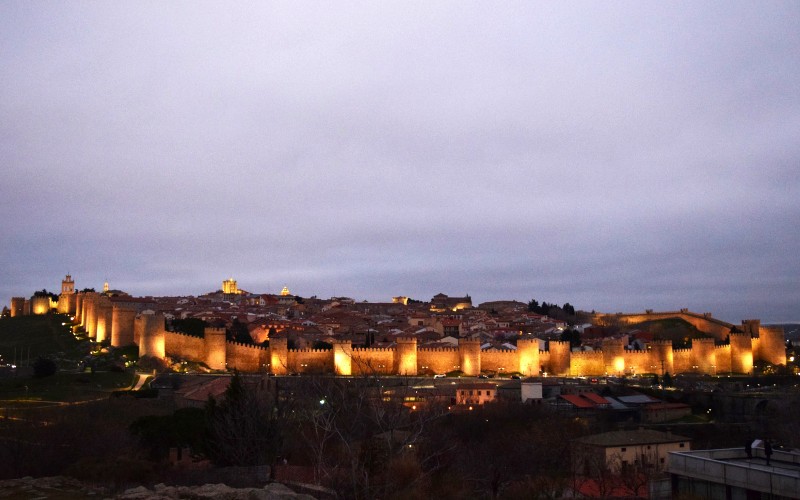
An incredibly popular day trip from Madrid is Avila. Tours will often combine it with a visit to Segovia. If you are looking to get the most out of your time in Spain, that could be a really good option.
As you approach Avila from the outside, it looks spectacular, is it a walled city with some of the most eye-catching fortifications you will see thanks to years of restoration work. It really is postcard perfect.
However, on my visit to Avila, once I had breached the city walls, I found it a little underwhelming. As with most Spanish cities, there are plenty of churches to visit, and the main cathedral is pretty spectacular. The walk around the top of the walls was a really nice experience, but other than that, I didn’t find a whole lot more that really stands out about the city.
While Avila is a nice side trip from Madrid, if you allow a full day here, you may find yourself getting a little bored by the end, but it is certainly worth visiting. It is a nice stop on the way to Salamanca, or as mentioned previously, part of a multi-stop organised tour.
Top things to see do in Avila
- The Walls of Ávila – The city walls are among the best-preserved medieval fortifications in Spain and a UNESCO World Heritage site. They can be enjoyed from a distance or also walking along the top.
- The tourist train – a nice little tour which is a great way to get a concise history of Avila and see the main sites. It will also take you to a viewpoint out side of the city to get nice photos of the walls.
- Ávila Cathedral (The Cathedral of the Saviour) – Integrated into the city’s defense system, this cathedral is one of the first Gothic cathedrals in Spain and offers architectural and spiritual insights.
What to eat
- Amarguillos – traditional almond flavoured pastries
- Yemas de Santa Teresa – a sweet made from egg yolks
How to get to Avila from Madrid
The best way to see Avila is either by organised tour or driving yourself. This gives you the most flexibility to see as much as possible in a day. It is a simple drive, motorways all the way (with a toll), but leaving Madrid can get busy at peak times.
There are nearly 20 trains a day that go between Madrid and Avila, but they are not high-speed trains so take around 1 hour and 45 minutes. I would not recommend this as an option.
9. Zaragoza
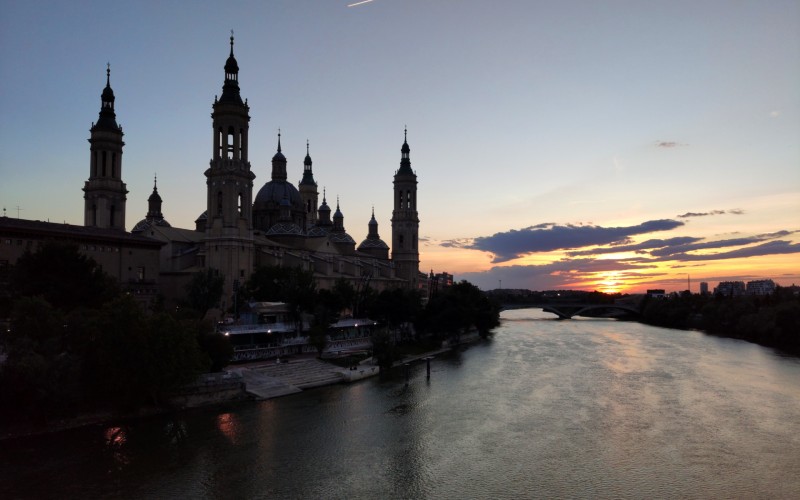
I visited Zaragoza recently, and although I must admit I cheated, it was an overnight trip, not a day trip; however, the fact that it is a very pretty city and on the high-speed train line certainly makes it worth considering.
In fact, it is the only stop between Madrid and Barcelona, so if you are travelling between the two cities, I would highly recommend breaking your ride up a bit and spending a few hours exploring Zaragoza.
The city’s heart lies in the Plaza Nuestra Señora del Pilar. It is a huge square where you will find the gorgeous Basilica of Our Lady of the Pillar, that faces onto the River Ebro, La SEO Cathedral and the entrance to the historic Roman parts of the city.
However, my highlight is a network of alleyways called El Tubo. It is home to many small bars and restaurants, each specialising in a different type of tapas. We eat some mushroom burgers, croquettes, migas and much more, if you love your food and drink, you will not want to leave.
If you would like to read a more in-depth guide, check out my what to see in Zaragoza post to be fully inspired.
Top things to see in Zaragoza
- La SEO Cathedral – an amazing mix of architectural styles throughout the years.
- Basílica de Nuestra Señora del Pilar – Simply stunning from the outside and home to a dome that was painted by Goya and a tower you can get to the top of for wonderful views.
- Aljafería Palace – an old Moorish palace and a stunning example of Islamic architecture in Northern Spain with some lovely courtyards.
- Cross Stone Bridge – cross the old river bridge and look back across the Ebro for great views of the Basilica.
What to eat
- Everything . . . in El Tubo
How to get to Segovia from Madrid
Once again we’re back on the AVE High-Speed Train. Zaragoza is on the high-speed train route between Madrid and Barcelona meaning there are loads of departures from Atocha station throughout the day. It takes about 1 hour and 45 minutes to get to Zaragoza-Delicias station. As mentioned above, it can also be a nice way to break up a journey between Madrid and Barcelona.
10. Aranjuez
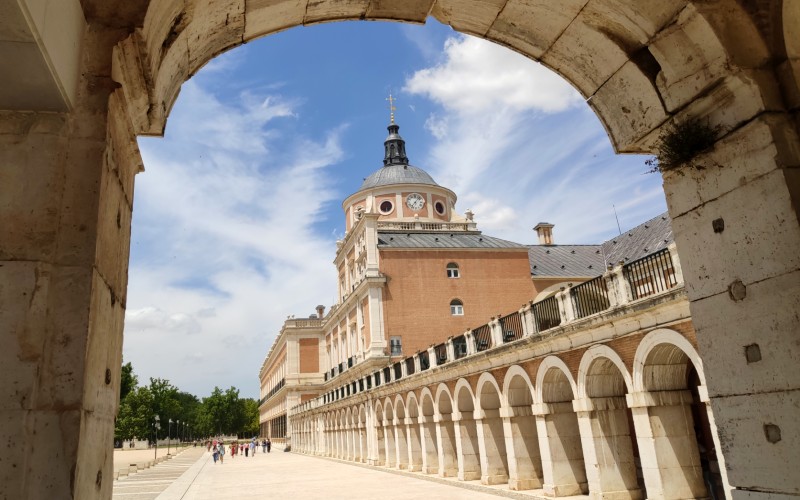
The small town of Aranjuez is a nice escape from the city of Madrid. It is only 45 minutes by car or a little under an hour by Renfe Cercanías (Commuter Train). However, most visitors to the city take what is known as the Strawberry Train.
The area of Aranjuez was a traditional strawberry producing powerhouse, and the Strawberry Train tries to take you back to this era. You get on the train at the old railway station which is now the Madrid Train Museum and an old school (read: uncomfortable) train carriage will take you to the town.
The train guards dress up in traditional clothing and on your return to the city you get given a serving of strawberries.
The biggest draw in the town is the huge royal palace and expansive gardens. Aranjuez has been one of the Royal Estates of the Crown of Spain since 1560 and for nearly 200 years, until 1752, only the royalty and nobility were allowed to live in the town.
In fact, the Aranjuez Cultural Landscape is recognized as a UNESCO World Heritage site. This cultural landscape includes the palace and surrounding gardens, reflecting the concept of an ideal city that influenced landscape design in the Americas.
Top things to see in Aranjuez
- Royal Palace of Aranjuez – A beautiful palace that is a key attraction, famous for its blend of architectural styles and its historical significance as a former residence of the Spanish royal family.
- Prince’s Garden (Jardín del Príncipe) – Famous for its wide variety of flora, historical buildings, and the peaceful Falúas Museum (Museo de las Falúas Reales), which houses historic royal pleasure boats.
- Plaza de Toros – one of the oldest in Spain.
What to eat
- Fresas de Aranjuez (Strawberries of Aranjuez of course) – as mentioned, Aranjuez is famous for its strawberries. When visiting, you must sample these locally grown fruits.
- Menestra de Verduras – A vegetable stew and a typical dish in Aranjuez, reflecting the agricultural richness of the region.
How to get to Aranjuez from Madrid
If you choose not to take the strawberry train, The C3 Renfe Cercanías line directly connects Madrid’s Atocha Station with Aranjuez. Regular bus services also link Madrid to Aranjuez from the Méndez Álvaro bus terminal (Estacion Sur).
Alternativly, if you want to kick it easy, other organised tours will take you to the town or you can also drive yourself. It will take around 45 minutes heading south from Madrid.
11. Ribera del Duero

I’m back with another wine region. While outside of Spain, there is no doubt Rioja is considered the best wine from the country, however, those in the know also talk about this smaller wine region named Ribera del Duero. It is home to some of Spain’s top winemakers and, unlike Rioja, is within reach of a day trip from Madrid.
The Ribera del Duero wine route runs along the Duero river, the same one that flows all the way through Portugal and is famous for Port wine. But this is nearer the beginning of the river’s life. It covers a length of over 70 miles through Castile-León.
There are many underground wine cellars to discover in the region, a wonderful mix of famous producers and small family affairs.
Top things to see in Ribera del Duero
- Vineyards – lots of them. Bodegas Protos is my personal favourite.
- Aranda de Duero – a nice little town in the area.
What to eat
- Grapes . . . in their liquified state
How to get to Ribera del Duero from Madrid
If you are visiting wine regions, I would always recommend taking a tour as you can then relax and enjoy without worrying about drink-drive limits.
If you would rather take public transport, you can get buses to various towns in the region from Valladolid which is reachable from Madrid by train or intercity bus.
12. Chinchón
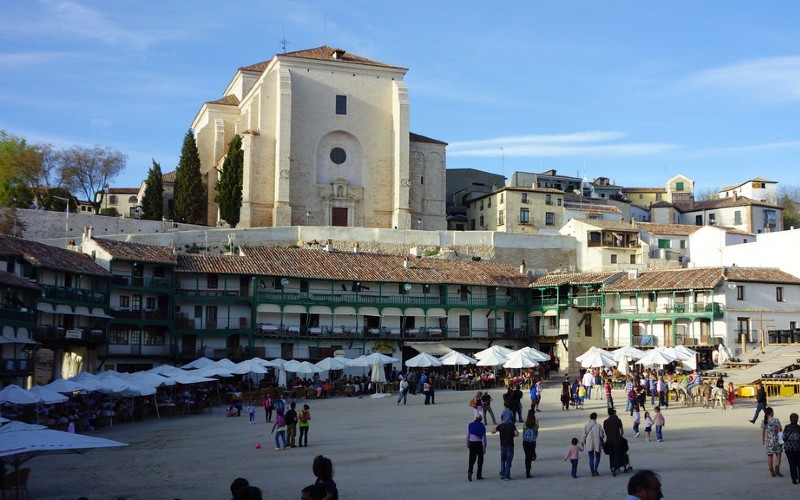
Probably the least famous town on this list, Chinchón is home to one of Spain’s prettiest Plaza Mayors.
The Medieval plaza is surrounded by old buildings with iconic wooden balconies, it is like a little time trap as you step into the past.
The Church of Nuestra Señora de la Asunción sits atop a hill, overlooking the town and is home to a piece of early work by Goya, one of Spain’s most famous artists.
One other thing to bear in mind, if you are travelling with teenagers, Chinchón is really close to the Warner Brothers Theme Park. If Theme Parks are not your thing, just drop your kids there for the day while you explore the town.
Top things to see in Chinchon
- Chinchón Castle – Also known as Castillo de los Condes, although mostly in ruins, it still offers a glimpse into Spain’s feudal past and is a point of interest for visitors.
- Church of Nuestra Señora de la Asunción – A lovely church that houses “The Assumption of the Virgin”, a painting by Goya, making it an important cultural and historical site.
- The Clock Tower – Standing as a solitary remnant of a destroyed church, it is an iconic symbol of the town.
What to eat
- Garlic Soup – The town loves its garlic, they even have a festival in honour of the delicious little edible bulb every October.
- Drink Anisette – Chinchón’s famous anise liqueur. Adding on a visit to a local distillery can be a fascinating experience.
How to get to Chinchón from Madrid
The best way is driving. If you have a car it is about 45 minutes to drive to Chinchón from Madrid.
13. El Escorial & The Valley of the Fallen
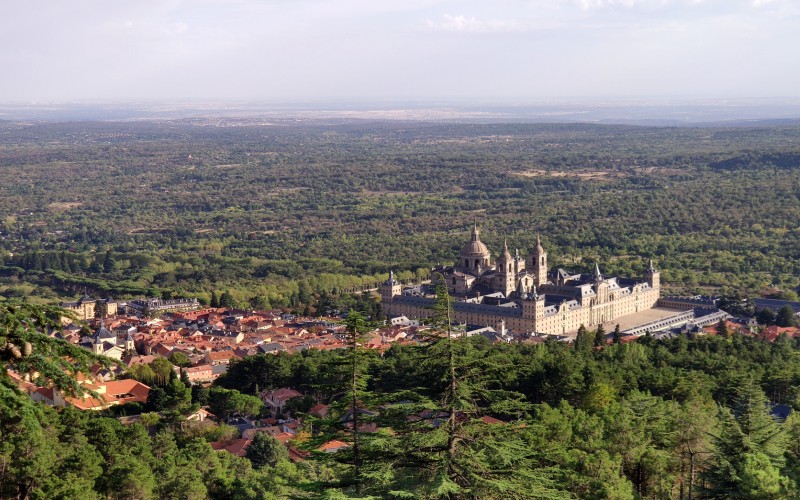
El Escorial is a town just to the north of Madrid that most people visit to see the imposing Royal Seat of San Lorenzo de El Escorial, and the nearby Valley of the Fallen, a Catholic basilica and controversial civil war memorial.
The Royal Seat of San Lorenzo de El Escorial can get confusing as it is also known as the Monasterio del Escorial, is a large palace that dates back to the 16th century.
Visitors can spend hours exploring the hallways and gardens, but my stand out memory was the catacombs. There are many tombs of famous royals from throughout history, but none quite as spectacular as the Panteón Real de El Escorial, a small room down a long flight of stairs that only the top of the royal hierarchy can be laid to rest.
The room glows in red and gold with a magnificent chandelier hanging high above your head. The coffins are vertically lined up the walls with the names of the ex-monarchs. I would love to show you, but it is not allowed to take photos.
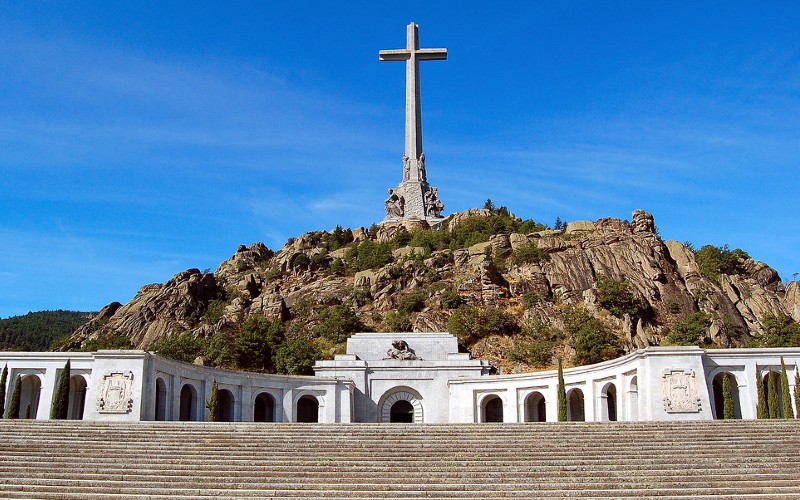
About 20-minutes up the road from El Escorial is The Valle de Los Caídos, which translates to The Valley of the Fallen. A huge cross in the mountains marks the site of this basilica that was built during the Franco regime.
Franco claimed that the monument was meant to be a “national act of atonement” and reconciliation with fighters from both sides of the war buried there, although much of it was built through the forced labour of political prisoners.
But, as it was also the burial site of Franco himself, it became a shrine for the far-right and detested by many Spaniards.
However, that was up until October 2019, when Franco’s body was exhumed and relocated to the understated (by Spanish standards) El Pardo-Mingorrubio cemetery.
While moving the body proved to be a controversial move that divided opinions across the country, the aim of the government is to see The Valle de Los Caídos move away from a site where Spain’s far-right pay homage to the dictator and become “a place of commemoration, remembrance and homage to the victims of the war”.
No matter what your political persuasion, there is no doubt the monument is an impressive maker to the bloody past of a dark time in Spain’s history.
Top things to see in El Escorial
- Royal Seat of San Lorenzo de El Escorial – It’s not only a royal palace but also a monastery, a school, and a historical burial place for the kings of Spain.
- The Cross – a towering 150-meter (500 ft) cross which is one of the largest in the world and visible from miles away.
- The Basilica and Abbey at The Valley – an underground basilica carved into the rock with a Benedictine abbey adjacent to the complex.
What to eat
- Suckling pig roasted in a traditional wood oven
How to get to El Escorial from Madrid
El Escorial is about 50km by car from Madrid and will take a little over an hour to get to. It is also easily reachable by public transport. Trains to El Escorial leave from Atocha or Chamartín station. They are the municipal Cercanías Renfe lines which mean there are a lot of stops, but they are also cheap. Take line C-8 or C-3 which depart every hour and the journey lasts approximately one hour.
Once you arrive at the El Escorial train station, it is about a 15 – 20-minute walk uphill to get to Monastery of El Escorial. However, there are also plenty of tuk-tuk drivers who offer tours of the town and trips up to some wonderful viewpoints.
If you wish to tie in a visit to The Valley of the Fallen, you can either take a taxi from El Escorial or a tour. You can also organise private tours that will take you to both sites with pick up and drop off. As always, this will be a bit more expensive but that’s the price for a stress-free trip.
14. Alcalá de Henares
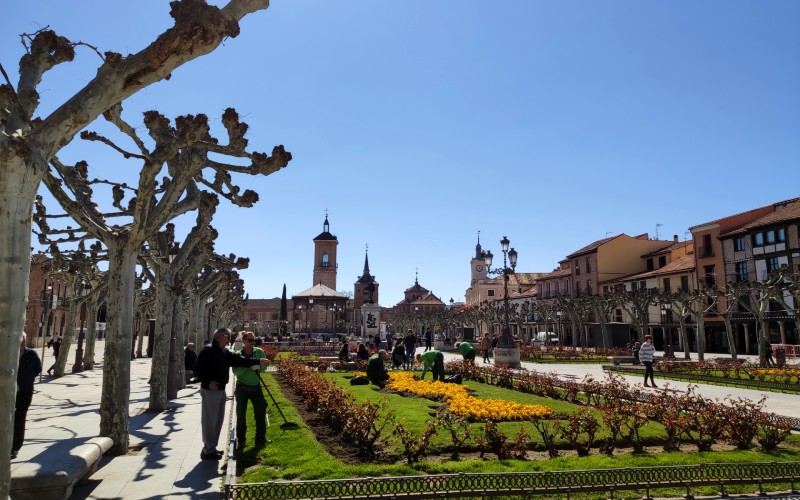
Alcala de Henares is a town that is one of the more popular side trips from Madrid as it can easily be visited using Madrid’s Cercanías rail system. It is a university town that is most famous for being the birthplace of Miguel de Cervantes, the author of Spain’s most famous literary work, Don Quixote.
As you’d expect, the town is home to the Cervantes Birthplace Museum where you can learn about the life and inspiration of the “Spanish Shakespeare”. The town also has some wonderful large squares and impressive Mudejar architecture.
Top things to see in Alcala de Henares
- Cervantes Birthplace Museum
- Plaza de Cervantes
- Laredo palace
- Torre De Santa Maria
- Regional Archaeological Museum of Madrid
What to eat
- Rosquillas de Alcalá – traditional Spanish doughnut-shaped pastries dunked into a creamy glaze
How to get to Alcala de Henares from Madrid
It takes a little over 35 minutes to drive from Madrid to Alcala, but there is also a local train on Madrid’s public transport system that will take you there. The C-2 Cercanías line runs from Atocha to Alcala de Henares. It takes about 45 minutes and trains leave every half hour or so. Alcala de Henares is in zone B-3 which means a return ticket can be bought for less than €5.
If you want to just relax and enjoy the day, then tours with pick up and drop off are available and offer good value.
15. Monasterio de Piedra
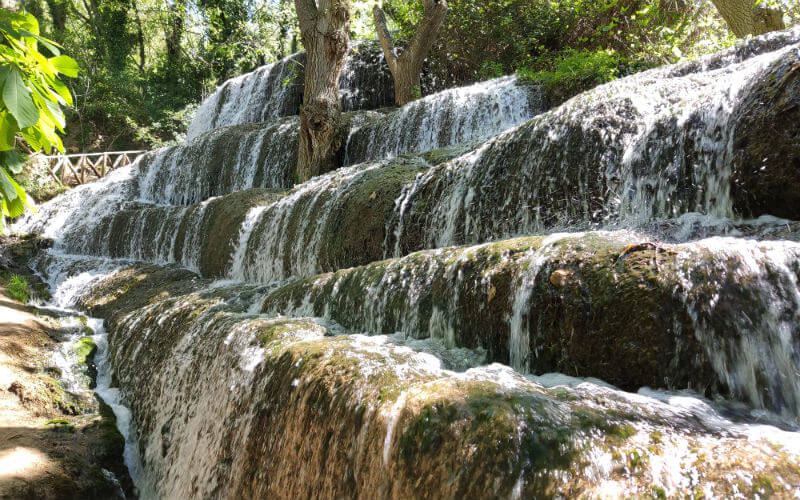
The Monasterio de Piedra Natural Park is a large park and monastery a little over 2 hours outside of Madrid.
Years of erosion by the Rio Piedra have created some spectacular waterfalls that visitors can visit and wander around. The route even takes you behind one of the largest in the park.
The site has also been carefully landscaped over many years by the monks that live in the monastery on site. The result is a wonderful harmony of natural falls and crafted waterways to impress the many visitors.
As well as the park you can visit the monastery itself and a small wine and chocolate museum with winemaking exhibits and information about the relationship between monks and winemaking as a commercial business to fund their way of life.
Top things to see in Monasterio de Piedra Natural Park
- Waterfalls & Lakes
- Grass
- Eagles
- Wine
- Chocolate
What to eat
- Trucha a la Piedra – trout cooked in the style of Piedra
- Chocolate – lots of it obviously
How to get to Monasterio de Piedra from Madrid
The best way is by far to drive yourself, but there are bus and train options. I have broken it all down in my other post specific to a day trip to Monasterio de Piedra. If you would like an in-depth look about how to get there, you can find it near the top of the post as well as some more tips about what to expect from the park.
Final thoughts on the best day trips from Madrid
While I do love living in the city of Madrid, one of my favourite things to do is leave it behind for a day and explore further afield.
In this post, I haven’t even mentioned some of the micro trips and things to do in surrounding towns in Madrid. You can visit sites such as the unique cathedral in Mejorada Del Campo or eat olives in Campo Real.
Whether you are in Madrid for a week or a year, I hope you have found some inspiration in this post and are ready to explore some amazing places.
If you know of anything I may have missed off of this list, drop it in the comments, I’d love to check it out myself some time and maybe add it to the list.
